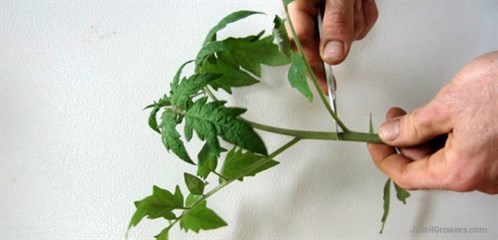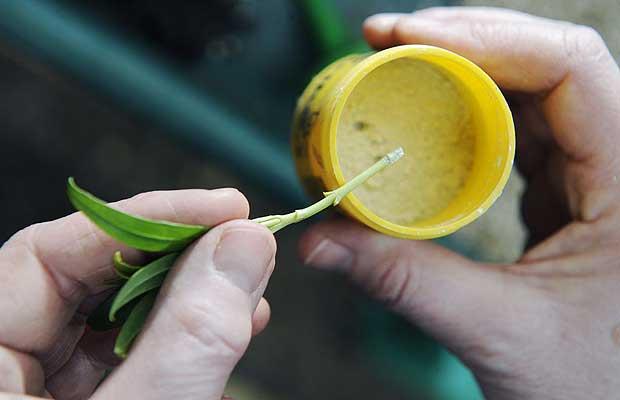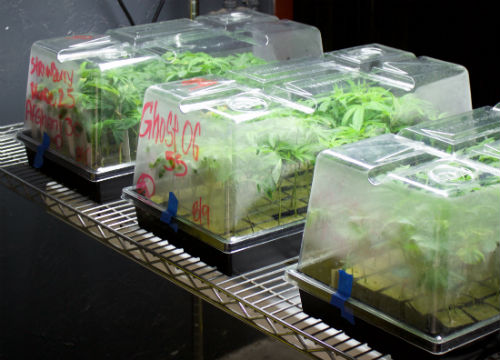Hello caregivers! In our last few articles, we touched upon how to figure out the strains you want to grow and how to find them. In today’s article, we want to talk about maintaining your stock of strains so you won’t need to worry about obtaining them again!
Maintaining Your Mother(s)
You may have sometimes heard of growers talking about their “mother” plants or stock plants. What exactly are these plants?
Essentially a mother plant is a cannabis plant that has been kept in its vegetative state in order to help propagate new plants. This mother plant will serve as the source of the genetics in your grow. It is kept in a prolonged vegetative state in order to keep it constantly growing without worry of death.
You will want to keep your mother plants in a separate room or tent of their own, so as not to accidentally induce flowering in them. Your mother plants should always be kept on a vegetative lighting cycle (18 hours on, 6 hours off), and given the best care and nutrients that you can provide. Because these plants are intended to provide the clones for the rest of your grow, they should not be under any significant stress, as this can have very negative consequences down the line.
Some growers opt to maintain the same mother plants for years on end. We have heard of some mother plants persisting for 15+ years. While this might seem appealing to a grower so they don’t have to worry about replacing their mothers, we can’t advise this approach. Cannabis is an annual plant, and prolonging its life well past its normal expiration date could have negative consequences and place stress on the plant. It is advisable that you cycle your mothers out periodically once every 6 months to a year to prevent this from happening. Your next mother should be taken from one of the very best clones from your current mother.
Cloning
The vast majority of growers we’ve spoken with on Growers Network maintain their strain variety and genetics through the vegetative cloning process. Unlike cloning animals, which comes with a whole host of problems, cloning plants is relatively simple and can even occur naturally.
But first, some of you may be curious as to why we use cloning instead of seeds. The simple explanation is that seeds are the result of sexual reproduction, and sexual reproduction can result in significant genetic changes in your plants. These changes could be welcome or unwelcome, but every time you reproduce via seed, you are changing your genetic stock to something different.
How to Clone
In our 100s series, we briefly described the cloning process in general terms. Let’s get a little bit more specific. In order to take clones, we need to take cuttings from a “mother” or stock plant that will serve as the source of our genetics.
The cloning process is time-sensitive, and speed and precision are of the utmost importance. Before you start taking cuttings, make sure you have all the materials you need and are in a place where you can focus on the task. Here are the materials you’ll want:
- Personal Protective Equipment (PPE) including a face mask, goggles (or glasses), and gloves. We do not want stuff getting in our eyes or mouths.
- A sharp scalpel or razor blade. Be sure to sanitize your cutting tool with alcohol before making a cut, then dry the cutting tool. You don’t want to contaminate the cutting with anything. Do not use scissors because they can crush sensitive xylem and phloem.
- A rooting hormone of your pick. The hormone should have Indole-3-Butyric Acid (IBA) in it that will help the cutting take root.
- A rooting media of your choice. Make sure your medium is prepared to receive the clones. Some medias such as rockwool require pH remediation prior to planting.
- A cloning tray and dome to store the cutting in while it first takes root.
- A spray bottle with water.
- A clean, stainless steel, aluminum, or hard plastic table to work on.
- A good office chair.

To take a proper cutting, you want to cut just above the nearest node on your mother plant. You want to use a very sharp blade such as a scalpel to make the cut, and you want to completely sever the cutting with no dangling fibers. You should make the cut as smoothly and evenly as possible, and at a 45-60 degree angle. If the cutting has dangling fibers, you will want to toss it aside and start again. Always make sure that your blade is sharp!

Once you’ve taken a good cutting, quickly but gently dip it in rooting hormone so that the now exposed xylem and phloem on the bottom of the cutting have thorough exposure to the hormone. You should probably keep the rooting hormone in a separate container so that you don’t contaminate your hormones bottle.
From there, you will want to gently place the cutting with rooting hormone into the medium you chose to use, and then put the medium and cutting inside your cloning tray.
When you have filled up your tray with the cuttings, you are almost done! Give the little cuttings a gentle misting of water from your spray bottle to get them nice and wet, and then place the dome for the tray on top. We want to make sure the dome is very humid, so if you see any signs that the cuttings are drying out, give it another spray. If the cuttings dry out, they will die very quickly.
Now you want to take a piece of masking tape and put a label on your cloning tray with a pen or Sharpie. Clones of different strains can look identical, so we want to indicate what strain it is and the date when the cuttings were made.

From there, you’ll want to take your tray and dome into your propagation area, which should have T5 lights or LED lights. These lights are generally much gentler on cuttings, giving them time to take root after the cutting process. We are not in a hurry with our cuttings! Give them as much time as they need. Your rooting hormones should make the process faster and more likely to succeed, so it is worth investigating how good a rooting hormone is.
Seeds
“Hold on!” I hear you say. “I thought we were just using clones to maintain our genetics!”
And you’re mostly right. Clones are our ideal way of maintaining genetic regularity throughout our grows. However, mother plants and clones require continuous ongoing growth, and sometimes something bad may happen. There are many different ways a grow can go wrong. As is commonly expressed, “S*** happens!”
This is where seeds can come into play. Cannabis seeds tend to last a very long time before they start to lose some of their shelf life. As a backup plan in case something goes wrong, you should have a few seeds of each strain that you grow stored in a safe, cool, dry place. Some growers I’ve spoken with have said that their seeds have lasted decades, which is extremely useful as a backup plan in case something happens. This way, even if you lose your crop or your entire facility, you aren’t starting completely from scratch.
We’ll talk more about how to make your own seeds in our next How-to-Grow Cannabis article, where we discuss breeding, but for now know that they can be of great value in maintaining your genetic stock.
Conclusion
Now you should have a stable genetic stock and a backup plan in case anything goes wrong. You can start building your genetic portfolio and provide your patients and clients with everything they could want, and may even be able to sell some clones to other growers if they need them.
Stay tuned for more How-to-Grow Cannabis articles! If you can’t wait to see the next article, or you have a specific question, join our community and start talking!
10 Best Gift Ideas for Cannabis Connoisseurs and Growing Aficionados (2022)
December 7, 2022Developing and Optimizing a Cannabis Cultivation System
December 14, 2021Dealing with Insomnia: How Can CBD Help?
December 10, 2020Your Guide to Sleep and CBD
December 7, 2020
Do you want to receive the next Grower's Spotlight as soon as it's available? Sign up below!

Do you have any questions or comments?

About the Author
Hunter Wilson is a community builder with Growers Network. He graduated from the University of Arizona in 2011 with a Masters in Teaching and in 2007 with a Bachelors in Biology.
